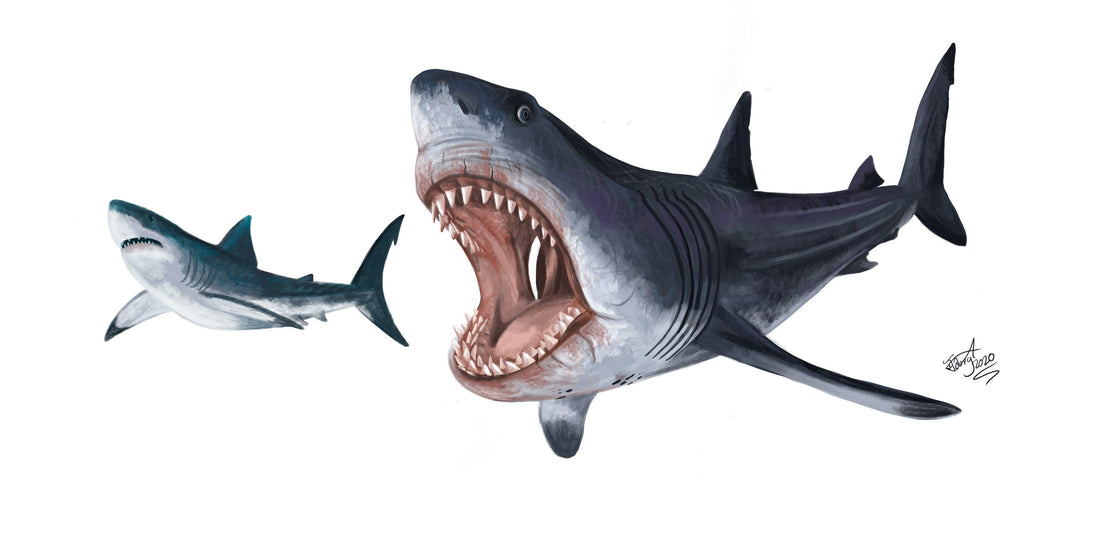
Megalodon - The largest predatory shark the world has ever known
Share
Carcharocles megalodon
Pronounced “Car-care-oh-klees Meg-uh-low-don”
Means “Large toothed glorious shark”
Named for its giant teeth
“Megalodon” lived from 23 (Miocene) to 3.6 (Pliocene) million years ago
Worldwide
Carcharocles megalodon (Agassiz, 1843) is the best-known-to-the-public shark, thanks to its gigantic serrated teeth and fantastic jaw recreations that appear in museums around the world. With a mouth over 6 1/2' wide, laden with over 250 gigantic teeth (the largest known is over 7" tall!) in 5 rows, this shark is deserving of its limelight!
In paleontologic circles, there is some debate on which genus the teeth of Megalodon should be ascribed to. The similarity of their giant teeth to those of the Great White Shark (Carcharodon carcharias) led researchers to ascribe Megalodon to the genus Carcharodon.

(The giant teeth belong to C. megalodon, the small tooth in the middle? A 19' Great White Shark!)
More recently two camps have emerged, one arguing it belongs to the genus Carcharocles, while another argues it should be called Otodus megalodon. The cartilaginous bones of a shark mean only in the rarest of circumstances does the cartilage actually fossilize, thus researchers invariably are left to conduct studies using only teeth. Thankfully they are numerous as they are shed throughout the life of a shark, leaving thousands of potentials fossils to be found. Fossil Crates uses Carcharocles today but, as is always the case in paleontology, a new discovery can rapidly change facts. In this blog article I will use the common term Megalodon.
Megalodon teeth first appear in the Miocene, around 23 million years ago, and the shark goes extinct only 3.6 million years ago, in the Pliocene. Alas, there is no Megalodon roaming the deep seas today.
Megalodon size estimates range from 34' to 98' depending on the methodology being employed by the researcher writing the paper. The latest, and most carefully considered estimations, suggest an average length of 34' feet with giant individuals reaching 50' and weighing over 14 tons. This makes the shark longer and heavier than a big yellow school bus and puts it within 10' of the longest known shark, today's whale shark which can exceed 60. For perspective, the Great White Shark rarely reaches 20'. In the fossil record, the giant Cretoxyrhina likely reached "only" 26'.
Megalodon teeth could easily sever bone, especially when driven by one of the most powerful bites that ever existed. The shape of the tooth minimizes breakage should it strike bone, and is built to absorb forces that may have reached 40,000 lb-feet of force. A Tyrannosaurus bite has been hypothesized to reach 15,000 lb-feet of force. The Megalodon jaws could open upwards of 75 degrees, and if it bites like modern sharks once it latched on it would shake its head side-to-side, increasing the actual bite strength.
Megalodon could eat whatever it wanted, however, we know it enjoyed dining on whales as numerous whale skeletons have been found with flippers or even the tail having been bitten off, with deep Megalodon teeth gashes in the remaining bones. Removing a prey's propulsive capabilities makes for much easier, and safer, eating. Paleontologists hypothesize Megalodon may have also used its bone-crushing power to bite through the chests of whales, exposing the lungs and heart. Talk about a heartless predator...
Megalodon didn't always bite its prey first apparently as some whale fossils exhibit fractured ribs that didn't heal, suggesting they were rammed with extreme force. Megalodon could have easily generated rib-cracking energy as it is thought to have reached 35 mph in bursts. Modern sharks sometimes ram their prey making it easier to dispatch them and a Megalodon crashing into any animal, with its wide, blunt head, would have caused tremendous damage as well as stunned the prey.
The giant size of Megalodon suggests it may have been endothermic like some sharks today. This would have allowed it to operate in waters that were colder than a giant shark might normally be expected to inhabit, which is great for chasing whales.
Megalodon's specialization in whale-eating may have been what ultimately led to its extinction. The Ice Age began shortly before Megalodon went extinct. The chilling of the planet reduced water temperatures globally. Whales began moving into colder waters, possibly waters too cold for Megalodon to actively hunt in. Additionally, the modern Great White Shark appears around 4 million years ago. A reduction in large prey would mean the giant Megalodon would have to compete with the much smaller, yet nimbler, Great White for smaller creatures. Interestingly, it was only after Megalodon went extinct that whales attained the 100+' lengths and massive weights that they attain today. Could Megalodon's whale predation have kept whale sizes down? Megalodon wasn't the only whale-eater, aside from killer whales that enter the fossil record around the time Megalodon disappears, a whale-eating whale known as Livyatan, lived alongside Megalodon. At 57' long and substantially heavier than Megalodon, it was likely the one animal Megalodon steered clear of.
Megalodon was likely viviparous (live-birth) and its young probably practiced oophagy, where the first few baby sharks that develop teeth in the mother's womb go on a feeding frenzy, eating the rest of its siblings. A live-birthed baby Megalodon would have exceeded 11' and 500 lbs when born. Evolutionarily, giving birth to a small number of large offspring increases their chance of survival. Like modern sharks Megalodon returned to the same area year after year to give birth.
Megalodon is the State fossil of North Carolina and its teeth are commonly found in rivers in the south and southeastern US. The Megalodon tooth found in the Fossil Crates Marine Marauders crate was found in Florida and is one of the larger ones ever discovered.
My favorite image of Megalodon is one of an animal larger than a big yellow school bust bursting out of the water in a full breach!
Thank you kindly!
BC
